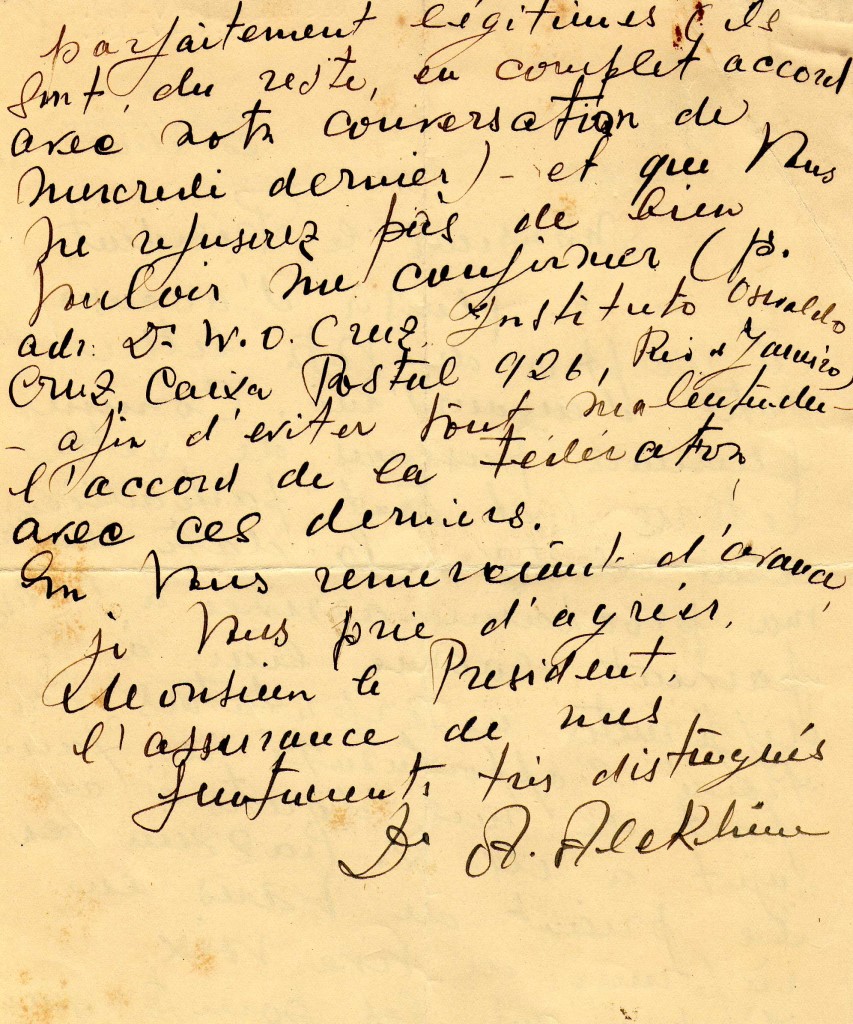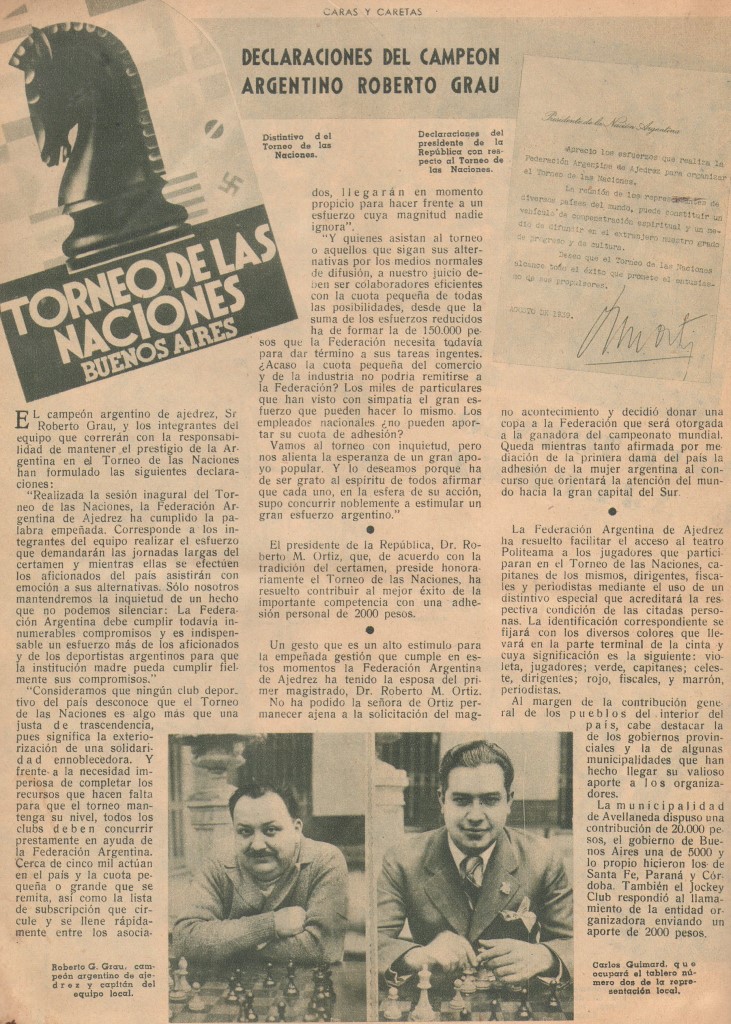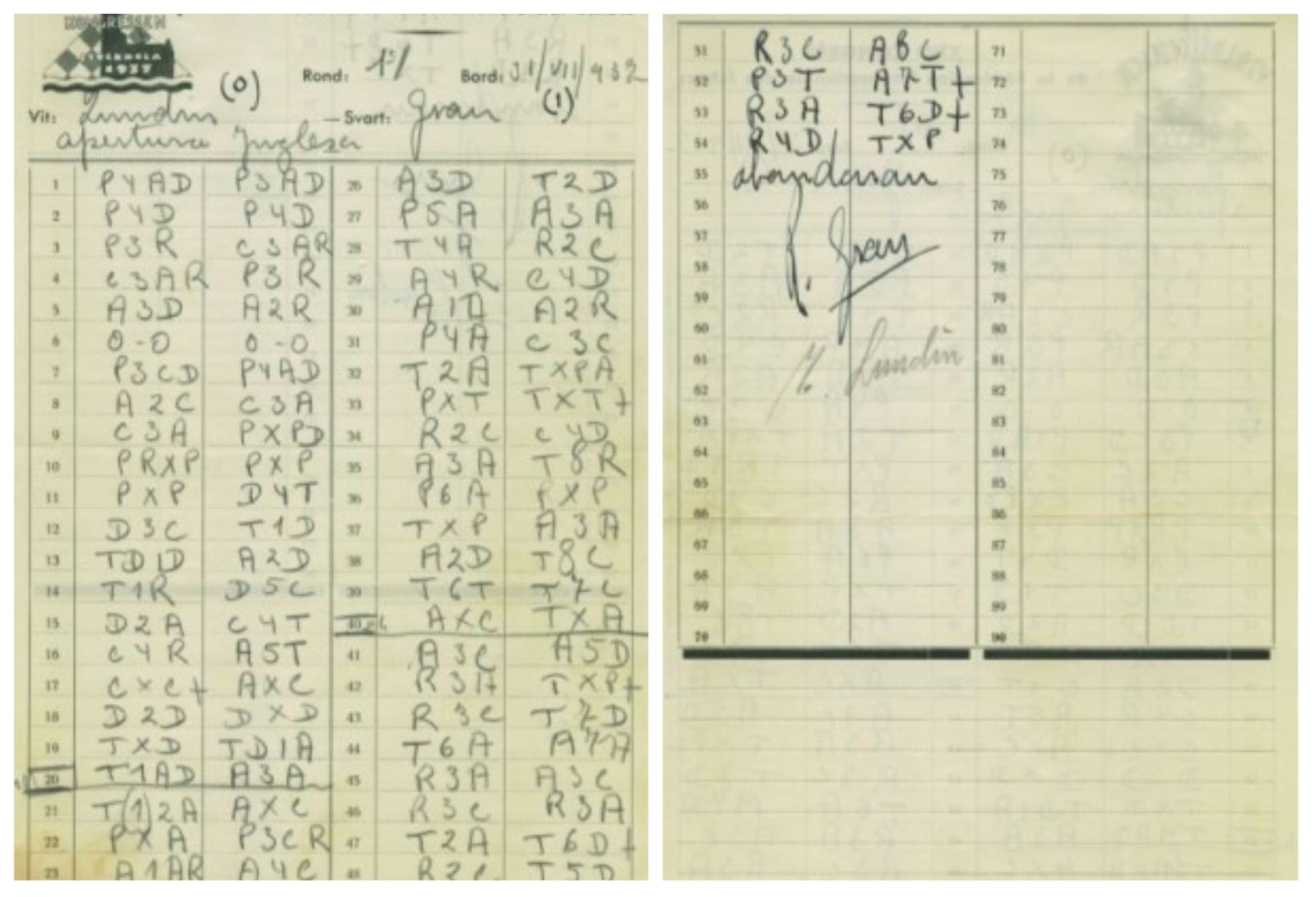


Morgado's book is structured as a chronology of the 1939 Chess Olympiad — then presented as Torneo de las Naciones — in the socio-political context in which it took place. The author managed a chess shop for 38 years (1981-2019), which favoured the progressive accumulation of historical and collectible materials: all Argentine chess magazines, diverse scrapbooks, complete collections of newspapers (La Nación and Crítica), a host of foreign magazines (Chess, British Chess Magazine, Xadrez Brasileiro, Deutsche Schachblätter, Deutsche Schachzeitung, plus other publications from Uruguay, Chile and Cuba, etc.), official and personal documents owned by grandmasters. The arrival of technology in the late 1990s facilitated the scanning, digitization and classification of the sources. The process lasted no fewer than 15 years.
 The historical and cultural concepts included in the book were based on the profound ideas of writer Ezequiel Martínez Estrada (1895-1964), mainly from the works he published in the 30s and 40s. In La Cabeza de Goliat, Martínez Estrada referred extensively to the Tournament of Nations and the Argentine chess players. He noted that plenty of the social features and dynamic forces that survived in the country from the colonial period influenced the chess event.
The historical and cultural concepts included in the book were based on the profound ideas of writer Ezequiel Martínez Estrada (1895-1964), mainly from the works he published in the 30s and 40s. In La Cabeza de Goliat, Martínez Estrada referred extensively to the Tournament of Nations and the Argentine chess players. He noted that plenty of the social features and dynamic forces that survived in the country from the colonial period influenced the chess event.
In 1941, Guillermo Puiggrós and Ignacio De María published a small book, which contained some games from the tournament, with brief comments. In 1946, Milcíades Lachaga managed to recover the actual scoresheets of the games, which had been auctioned by the Argentine Chess Federatioon (FADA) in 1941, when it went bankrupt. Lachaga compiled the games and published it with complete statistical data from the event. Much later, in 2000, Anthony J. Gillam published Buenos Aires Chess Olympiad (The Chess Player, 120 pages). Subsequently, an interesting work by José Antonio Copié was published, entitled Remember 1939 (2009, self-published, 74 pages), which collects interesting data. Three years later, in 2012, with the support of Senator Carlos Alberto Reutemann, Sergio Ernesto Negri and Enrique Julio Arguiñariz published La Generación Pionera 1924-1939 - Historia del ajedrez olímpico argentino (Senate of Argentina, 574 pages), which presents a detailed account of the event.
More recently, Pawns in a Greater Game (Gentext Publications, 2015, 382 pages) by Justin Corfield came out. Corfield is an Australian enthusiast who travelled the world and unveiled many details from the competition that had remained unknown.
This first volume includes, among other topics, a description of the Politeama Theatre, a characterization of the social and political conditions in Argentina and the world, the newspaper columns authored by Alekhine and Capablanca, documents about the negotiations of the Argentine Federation with the world champion, the international impact the tournament had, and a reproduction of the notes kept by an unusual collector, Dino Ruggieri, who authored what we have come to call la libreta mágica (the magic notebook).
The Politeama Theatre was one of the most important musical and theatrical venues of Buenos Aires since 1870. Among others, Eleonora Duse, Rosina Sarah Bernhardt, Giacomo Puccini, Otto Nordenskjold, Carlos Gardel, Discépolo and Eva Duarte performed in its premises.
 During the event and until almost three months later, frantic negotiations took place between Alekhine and Capablanca to play a rematch. On several occasions, it seemed like the arrangements were succeeding, which meant the long-awaited encounter would be played. However, inconveniences would frequently shatter the negotiations. Finally, the efforts ended in a scandal, as FADA President Dr. Carlos Querencio challenged Alekhine to a duel — the match, of course, never took place but Alekhine left for France and Capablanca did not get a chance to take revenge.
During the event and until almost three months later, frantic negotiations took place between Alekhine and Capablanca to play a rematch. On several occasions, it seemed like the arrangements were succeeding, which meant the long-awaited encounter would be played. However, inconveniences would frequently shatter the negotiations. Finally, the efforts ended in a scandal, as FADA President Dr. Carlos Querencio challenged Alekhine to a duel — the match, of course, never took place but Alekhine left for France and Capablanca did not get a chance to take revenge.
One of the chapters include the newspaper articles by Capablanca and Alekhine in Crítica and El Mundo, respectively. More than once, they attack each other in sibylline fashion.
[Pictured: A handwritten letter by Alekhine. Click to enlarge.]
On April 26, La Prensa publishes the shocking news that the Tournament of Nations had been cancelled due to a lack of funds. The Argentine Federation found itself in the afflicting obligation of communicating to FIDE and the 40 national federations registered that the tournament could not be played in Buenos Aires. In an extensive statement, FADA detailed how they got the consent of the FIDE delegates at the 1937 Congress, including the fact that Argentine President Agustín P. Justo had promised to assist the organizers. In fact, in the year's national budget, the government had included a $150,000 allowance to cover a portion of the expenses, totalling $360,000. The remaining $210,000 were to be provided by FADA.
In totally unwarranted and shameful fashion, Minister Jorge Coll decided that he would not "disburse the subsidy approved by Congress, because there are other priorities". At first, the leaders of FADA considered cancelling the event, but later decided to move on, mainly thanks to Roberto Grau's encouragement. To raise the necessary funds, they resorted to a national donation campaign. Grau himself offered to travel from north to south of the country giving simultaneous exhibitions and conferences to raise funds. Numerous groups were formed throughout the country, known as "Commissions of Honour", which were responsible for gathering contributions and then turning them to FADA. Thanks to this somewhat heroic effort, the tournament was relaunched, although during that period 18 of 45 federations cancelled their participation.
The second volume contains a detailed account of the day-by-day action of the Tournament of Nations, the Women's World Championship and the FIDE Congress. The most important chronicles of the newspapers and magazines of the time were selected and are reproduced. The drama caused by the declaration of World War II is widely described. The impact of the outbreak was documented with newspaper clippings, which showed the dramatic panorama of war events.
 The British team's abrupt withdrawal shocked the organizers. Then, the sporting struggle between Germany and Poland in the final group was seriously affected by the beastly military actions, and other nations were also dragged into that contest: France, Palestine, Bohemia and Moravia. The tournament was in serious danger of being cancelled, and only the strenuous work of the organizers, led by Augusto de Muro and Roberto Grau, saved the day. Grau expressed about Germany's triumph:
The British team's abrupt withdrawal shocked the organizers. Then, the sporting struggle between Germany and Poland in the final group was seriously affected by the beastly military actions, and other nations were also dragged into that contest: France, Palestine, Bohemia and Moravia. The tournament was in serious danger of being cancelled, and only the strenuous work of the organizers, led by Augusto de Muro and Roberto Grau, saved the day. Grau expressed about Germany's triumph:
We may have seen some unfair outcomes and the public's expectations might not have been met, but throughout a championship luck tends to even out and victory tends to be achieved by the most capable. The TN could not escape that rule. At the start of the event, I pointed out the likely contenders for first place, and my prediction was the basis for the subdivision of the preliminary series — I chose the following five teams: Germany, Poland, Argentina, Estonia and Sweden. That was also the order in which I placed them in the table, and the only difference is that our team, instead of third place, came fifth, albeit only one point behind Estonia, which got third place.
The inability of many of the participants to return to their countries due to the presence of submarines in the Atlantic caused additional difficulties, as the government had not yet paid a substantial portion of the subsidy. La Nación reported on September 25th, 1939:
A delegation of chess players headed by the Presidents of FIDE and FADA, Don Augusto De Muro, and which included former world champion José Raúl Capablanca, Dr. Savielly Tartakower and Argentine chess players Luis Palau, Roberto Grau and Luis Piazzini met with the President of Argentina, Roberto M. Ortiz, to greet him and express their gratitude for the cooperation provided during the event. In addition, Ortiz was informed that the ship in which the players will return to their countries will depart from our port next Friday, a circumstance that pushes them to turn to the balance of the subsidy approved by Congress in 1938, since that is the only source of money available for the payment of the ship tickets and the remaining hotel fees. The President listened sympathetically to the request and congratulated the players and managers on the success achieved in the competition.
The third volume analyses the social and political circumstances in Argentina and the world after the war was declared, and the influence that more than thirty strong chess players who remained in the country exerted on the structure of national chess. The Argentine Federation itself, official institutions, provinces, municipalities, companies, the Círculo, embassies and local clubs took immigrants in. The newcomers participated in countless activities, which gave them a minimum income to survive: tournaments, simultaneous exhibitions, conferences, classes, newspaper columns, books and even regular jobs. One exception was the sad case of Ilmar Raud, who died in distressing circumstances, discussed at the end of this volume.
The stateless Sonja Graf participated in the 1939 event and was able to survive eight years in Argentina, mostly thanks to chess activities and the two books she published — today, the books are highly sought after. His trip to Cordoba in 1942 is extensively documented with information from local newspapers.
Ariel Magnus's novel El que mueve las piezas, based on the magnificent tournament — previously reviewed in ChessBase (in Spanish) — is included with the addition of surprising new data contributed by the author.
Thanks to the courtesy of Swedish colleagues led by Peter Holmgren, we were able to add an important scoop: nine games, unknown until today, of the Argentine team that participated in the 1937 Stockholm Tournament of Nations.

Roberto Grau's scoresheet of his round one game at the 1937 Olympiad in Stockholm — he defeated Sweden's Erik Lundin with the black pieces